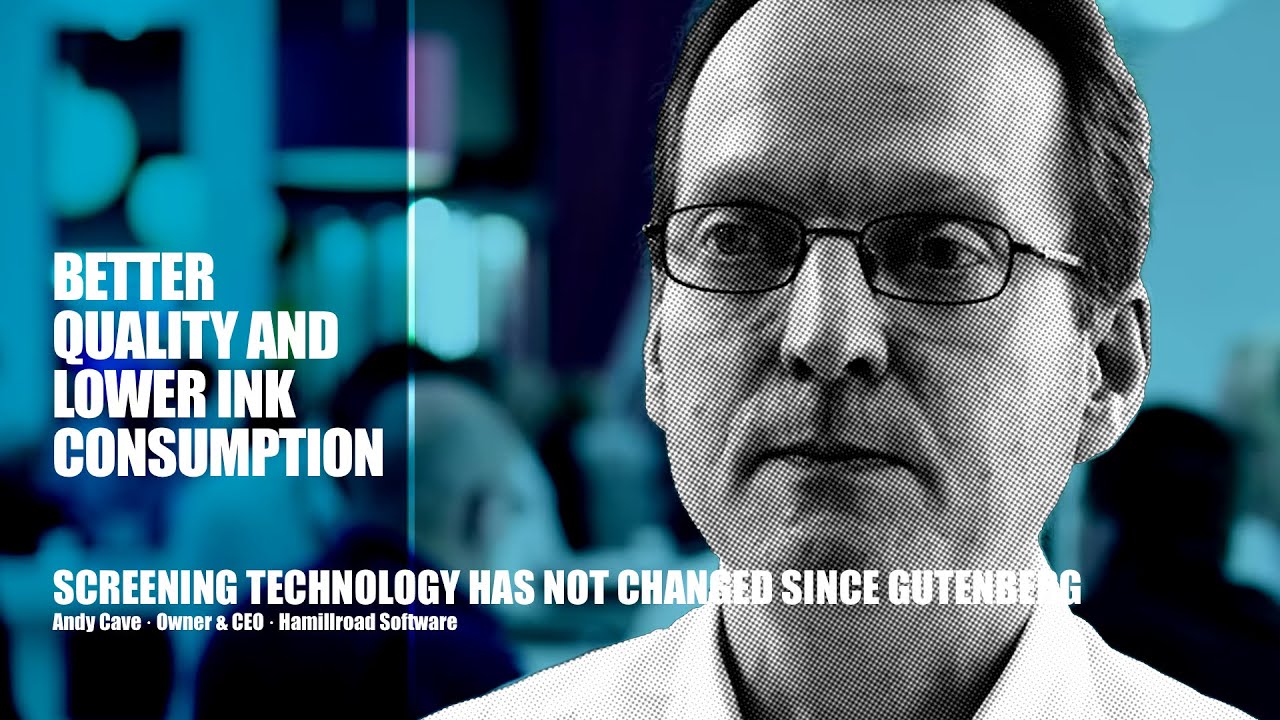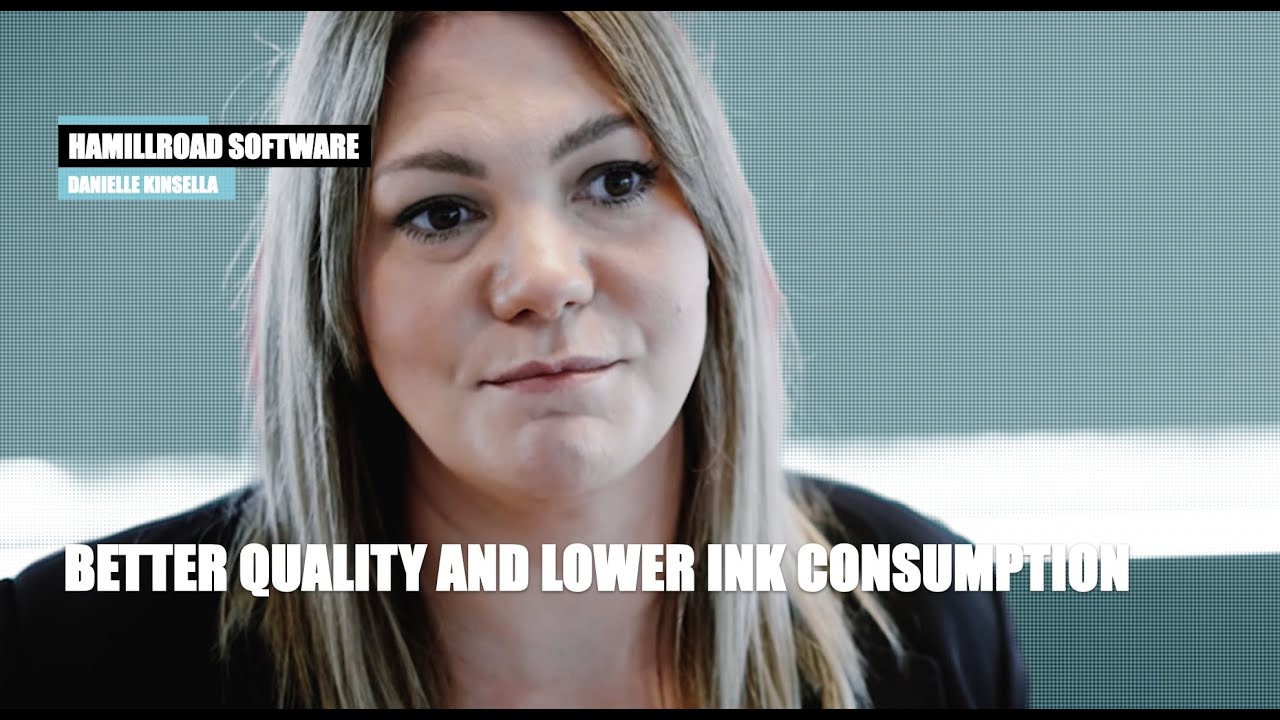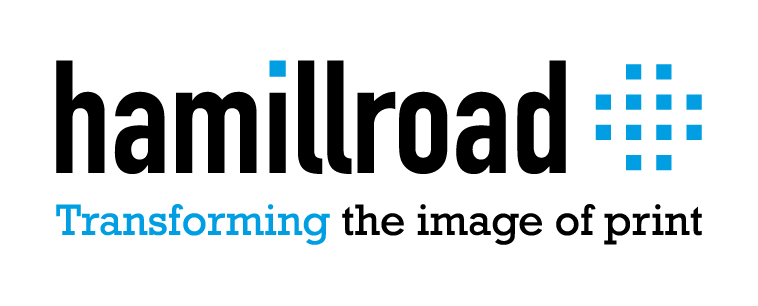Screening Technology hasn’t changed since Gutenberg · Andy Cave · Owner & CEO · Hamillroad Software
One of the more exciting companies we have met is for sure Hamillroad Software from the UK. We have mentioned the company on several occasions on INKISH. In this film, we talk to Owner & CEO Andy Cave about their amazing screening technology. The technology is called DMS – short for Digitally Modulated Screening, and no – it’s not AM, FM, Stochastic, or anything you know.
The most amazing thing about DMS is that the quality is stunning; at the same time, printers can save ink. Watch, Like, and Share this film – we LIKE it a lot
So we’re Hamillroad Software, we’re a software development company in prepress. We specialize, in particular, in digitally modulated screening. If you’d like me to expand a little on that, if you look at printing, you’ve got the gamut going through from the ranger, from making your plates through to the printing presses and if you look at the last 10 to 20 years, there’s been significant improvements all along that range of products. Plates have gone from film to direct to plate from chemistry to chem free. CTPs have gone from 2,400 to 4,800. Pressers have gone with automatic registration, automatic color correction but yet, if you look at the actual technology that goes on the plate, it hardly has changed and it’s still the same technology almost from when Gutenberg invented printing, and it’s really holding everything back. You don’t get what you expect and what you want.
So one of the things is we don’t actually need on a lithographic offset CTP we don’t need 4,800. We’ve developed some very sophisticated algorithms that actually maximize the use of 2,400 DPI, and I think that’s the power of software, that’s the power of the modern computers we have. If you look at what you can do on a current Intel i7, i9, it’s a hundred times more powerful than the computer you had 10 years ago, and I think there’s a lot there that you can utilize if you put your mind to it, which is exactly what we’ve done.
It is, and in that respect, it’s a little difficult to explain. So if I tried to relate it to what people know, if you look at AM screening, it’s stable. Okay, It has some issues like moiré but it’s stable, it uses big dots. In comparison, if you look at FM, they use much smaller dots and those smaller dots are not stable. So we’ve gone for a dot shape, that’s bigger, that’s stable, it’s still small, and we’ve done that by actually restricting it in one dimension. So we’ve actually pioneered rectangular dots and a rectangular dot, it limits the ink film thickness in one direction, but it still has an area that means you get a stable dot.
And that’s one of the incredible things with our DM screening, you don’t just, you almost get the quality for free, you get your 400 to 600 LPI without the issues of moiré but it effectively doesn’t cost you because in the technology, it restricts the ink film thickness, which means that we more efficiently filter light, which means you can use less ink to achieve the same color, and our customers are seeing in excess of 10% ink savings.
Several times over. I mean if you have a printer who, let’s say spends 10 million euros or dollars a year on ink, we would expect them to save 10% of that at least, and that’s just in ink alone. In addition to a 10% saving in ink, we get a 10% saving in water, so you take your water levels down, the dots are much more controllable, so you use less water because you’re putting less ink and less water, if you’re a heat set printer, it dries quicker. So in your closed loop drying system, which is typically driven with gas, you need to use less gas to dry the ink on the paper.
Well I think on the densities we would normally match what someone’s currently printing. So if somebody is hitting ISO standards for density, they would hit exactly the same solid in densities, and we would use a dot gain curve or a press curve to achieve, so that 50 will gain to 69, 70% depending on which ISO standard they’re aiming to achieve. But in achieving that color, they can lower their waters and lower their inks, and that, you know, when we train a new customer, the first thing we do is tell their press operators take your water down by 10% and drive your ink levels down as well. The other thing about our DM screening is, I say we use rectangular dots and we minimize, for example, the number of little internal corners and it means we have dots where you’ve got really good ink water balance.
So when you have something like a FM screen, where you have swirls and the swirls actually have little staircases around the corners and there you’re fighting ink, water balance and you have a lot of gain and you have issues where the horizontal parts of your swirls have good ink water balance, but the corners have terrible in water balance. This may not gain, this can fatten up and that leads to an inconsistency because we have the same consistent dots, not only is it good ink water balance on all the dots, but as I just said, they’re consistent.
We had a customer in Singapore who was using FM to do hexachrome and he said that his biggest issue was registration and if he got slightly out of register, he had a color shift, and in fact I can actually prove mathematically and physically that if you do a five micron misregister with FM of CMYK, you actually get a color shift. So, and in fact if you misregister with FM screening, I don’t want to name a brand, you actually get smoother results. So how do you tell your press guy, I want you to slightly misregister because it will improve the quality or you have a bad press operator who misregisters and prints, fairly well, then the next week your best press operator is on press, he gets perfect register and you’re now sending the customer something that looks noisy.
That’s just crazy, but I can prove it mathematically. With AM screening, it’s well known that if you misregister, you go from a clear centered rosette to a dot centered rosette. A clear centered rosette gives a soft result, a dot centered rosette is a harder, bittier result and if you do that, you get a color shift and you get what I call a noise shift from a soft to a hard centered rosette. With our DM technology, and it’s the same whether it’s litho or flexo or [inaudible 00:06:36]. We actually interleave the dots and that gives us two benefits. First of all, it reduces noise. So the reason we can make smooth browns is because the way we interleave the dots and we call that a stochastic rosette and we have two patents on that, two US patents. The second thing is this interleaving is what gives us no color shifts when we misregister. So our DM screening is much more forgiving on misregistration.
So moiré an interesting topic. It’s plagued the industry on and off for decades. A good printer who’s got everything under control, can minimize it, but you know, it can still rear its head and it’s not difficult to have an unhappy customer if you don’t pick it up. So one of the interesting things I think for me, and I’ll say this jokingly, with Auraia is that we have heatset customers and they have young press operators who they employ, they train and we’ll start using Auraia. These young press operators will grow up never knowing what moiré is, now isn’t that sad? We need to have a funeral for Mr moiré because he no longer exists. We never get screen moiré, we never get content moiré. You can print chef’s uniforms, Scottish tartan cloths, you know the worst nightmare, and in fact, clothing catalogs is a perfect application. Not only do we get the detail to show the cloths, the weaves, the stitching, we get the smooth colors on your browns, on your leathers, but there’s no content moiré and you don’t suddenly see a shirt that just looks [inaudible 00:08:19].
We provide it on a service model. At the end of the day, our customers, we know they saved money, and if as I was saying I mentioned a printer, 10 million ink spend will save $1 million. If we charge them something less than that, then clearly they’re making money, they’re actually having less press issues. We also hear they run their presses faster, so they actually run more jobs and they get the quality then almost for free. So our sales model is on an annual pricing or in some cases even a job based pricing. We’re sensitive to different pricing levels in different markets, but we’re aiming for our customers to make, to save more money than we get paid, which obviously they’re very happy about. That pricing also gets them everything included, so it gets them all their support, all the training, it gets them the upgrades, so every time we improve things, they get a new release or we make available a new release to them.
So, that is actually one of our biggest issues. A lot of our customers will not allow us to tell people they’re using it. In fact, some of our customers actually put in a contract, we’re not allowed to mention their name, and in fact, in some contracts we actually have penalties if we mention their name, we’re absolutely forbidden, we’re under NDA, and the simple reason is they don’t want their competitors to know how they doing it. They don’t want their customers to know how they’re doing it. They want to get a competitive edge, and we have customers winning very sizeable print contracts based on the quality of what we do.
So it’s really tough. I mean I have spoken to, for example, some major heatset print groups around the world, and when I phone them up and I say, “Well, we’ve got this fantastic product, it can actually improve your quality, it can actually improve your bottom line. Great ROI, save you money.” Their first question is, “Who’s using it?” I then, for example say, “Well, there are millions of magazines a day in certain countries being printed with our software, so who’s the printer that’s printing the millions of magazines? I can’t tell you.” Okay, and it’s so frustrating that if we could announce who some of our big customers are, I think almost every single major print group around the world would be knocking on our door.
Well, it’s actually a lot easier because we could sell our software for say $50,000 or $100,000 or $1 million, but then they have to do a capex, a capital expenditure. They have to go to the finance department, they have to look at the ROI. It’s a big cash outlay and margins are very tight in, especially in lighter graphic, obviously in flexo it’s a slightly more buoyant market, it’s growing. The litho market is declining in most sectors, and a lot of these companies, they have paper thin margins, they don’t have a lot of cash in the bank. The thing with what we offer, is actually it doesn’t cost. If you save $1,000 a job, a month, a week, a day, whatever it is, a 1,000 let’s say that as a figure and you are paying us let’s say half.
Okay, it’s a nice simple number. So you’re actually making $500 more, the 500 you’re paying us, is not costing you. It’s coming out of a $1,000 you’re saving. So I think it’s a model that when we say that to printers, there’s a little reaction initially because it’s different, it’s new. They’re used to spending $5,000 for a piece of software or $80,000 for an upgrade to a big workflow, for example. So when you say to them that over a year you maybe pay more, it takes a while to get their head around, but when you say it actually, whatever they are paying effectively comes out of the savings and doesn’t cost them, then actually it becomes very acceptable.



































































